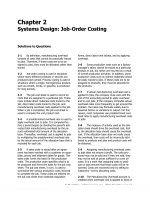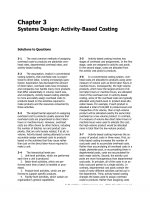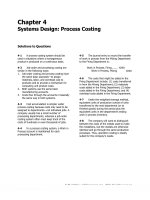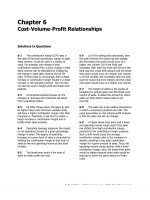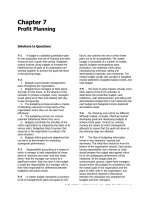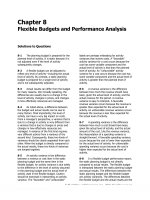Solution manual introduction managerial accounting 5e by garrison chapter 12
Bạn đang xem bản rút gọn của tài liệu. Xem và tải ngay bản đầy đủ của tài liệu tại đây (792.6 KB, 44 trang )
To download more slides, ebook, solutions and test bank, visit
Chapter 12
Capital Budgeting Decisions
Solutions to Questions
12-1 Capital budgeting screening decisions
concern whether a proposed investment project
passes a preset hurdle, such as a 15% rate of
return. Capital budgeting preference decisions
are concerned with choosing from among two or
more alternative investment projects, each of
which has passed the hurdle.
12-2 The ―time value of money‖ refers to the
fact that a dollar received today is more valuable
than a dollar received in the future simply
because a dollar received today can be invested
to yield more than a dollar in the future.
12-3 Discounting is the process of computing
the present value of a future cash flow.
Discounting gives recognition to the time value
of money and makes it possible to meaningfully
add together cash flows that occur at different
times.
12-4 Accounting net income is based on
accruals rather than on cash flows. The net
present value method focuses on cash flows.
12-5 Discounted cash flow methods are
superior to other methods of making capital
budgeting decisions because they recognize the
time value of money and take into account all
future cash flows.
12-8 No. The cost of capital is not simply the
interest paid on long-term debt. The cost of
capital is a weighted average of the individual
costs of all sources of financing, both debt and
equity.
12-9 The cost of capital is a hurdle that must
be cleared before an investment project will be
accepted. In the case of the net present value
method, the cost of capital is used as the
discount rate. If the net present value of the
project is positive, then the project is acceptable
because its rate of return is greater than the
cost of capital.
12-10 No. As the discount rate increases, the
present value of a given future cash flow
decreases. For example, the present value factor
for a discount rate of 12% for cash to be
received ten years from now is 0.322, whereas
the present value factor for a discount rate of
14% over the same period is 0.270. If the cash
to be received in ten years is $10,000, the
present value in the first case is $3,220, but only
$2,700 in the second case. Thus, as the
discount rate increases, the present value of a
given future cash flow decreases.
12-6 Net present value is the present value of
cash inflows less the present value of the cash
outflows. The net present value can be negative
if the present value of the outflows is greater
than the present value of the inflows.
12-11 The internal rate of return is more than
14% since the net present value is positive. The
internal rate of return would be 14% only if the
net present value (evaluated using a 14%
discount rate) is zero. The internal rate of return
would be less than 14% if the net present value
(evaluated using a 14% discount rate) is
negative.
12-7 One simplifying assumption is that all
cash flows occur at the end of a period. Another
is that all cash flows generated by an
investment project are immediately reinvested
at a rate of return equal to the discount rate.
12-12 The project profitability index is
computed by dividing the net present value of
the cash flows from an investment project by
the investment required. The index measures
the profit (in terms of net present value)
© The McGraw-Hill Companies, Inc., 2010
Solutions Manual, Chapter 12
613
To download more slides, ebook, solutions and test bank, visit
provided by each dollar of investment in a
project. The higher the project profitability
index, the more desirable is the investment
project.
12-13 The payback period is the length of time
for an investment to fully recover its initial cost
out of the cash receipts that it generates. The
payback method is used as a screening tool for
investment proposals. The payback method is
useful when a company has cash flow problems.
The payback method is also used in industries
where obsolescence is very rapid.
12-14 Neither the payback method nor the
simple rate of return method considers the time
value of money. Under both methods, a dollar
received in the future is weighed the same as a
dollar received today. Furthermore, the payback
method ignores all cash flows that occur after
the initial investment has been recovered.
© The McGraw-Hill Companies, Inc., 2010
614
Introduction to Managerial Accounting, 5th Edition
To download more slides, ebook, solutions and test bank, visit
Brief Exercise 12-1 (10 minutes)
1.
Item
Annual cost savings ..
Initial investment .....
Net present value .....
1-8
Now
Cash
Flow
12%
Factor
$7,000 4.968
$(40,000) 1.000
Cash
Flow
Years
Total
Cash
Flows
Year(s)
Present
Value of
Cash
Flows
$ 34,776
(40,000)
$ (5,224)
2.
Item
Annual cost savings ..
$7,000
Initial investment ..... $(40,000)
Net cash flow ...........
8
1
$ 56,000
(40,000)
$ 16,000
© The McGraw-Hill Companies, Inc., 2010. All rights reserved.
Solutions Manual, Chapter 12
615
To download more slides, ebook, solutions and test bank, visit
Brief Exercise 12-2 (10 minutes)
1. The project profitability index for each proposal is:
Proposal
Number
A
B
C
D
Net Present
Value
(a)
$36,000
$38,000
$35,000
$40,000
Investment
Required
(b)
$90,000
$100,000
$70,000
$120,000
Project Profitability
Index
(a) (b)
0.40
0.38
0.50
0.33
2. The ranking is:
Proposal Project Profitability
Number
Index
C
A
B
D
0.50
0.40
0.38
0.33
Note that proposal D has the highest net present value, but it ranks
lowest in terms of the project profitability index.
© The McGraw-Hill Companies, Inc., 2010. All rights reserved.
616
Introduction to Managerial Accounting, 5th Edition
To download more slides, ebook, solutions and test bank, visit
Brief Exercise 12-3 (10 minutes)
1. The payback period is determined as follows:
Year Investment Cash Inflow
1
2
3
4
5
6
7
8
9
10
$15,000
$8,000
$1,000
$2,000
$2,500
$4,000
$5,000
$6,000
$5,000
$4,000
$3,000
$2,000
Unrecovered
Investment
$14,000
$20,000
$17,500
$13,500
$8,500
$2,500
$0
$0
$0
$0
The investment in the project is fully recovered in the 7th year. To be
more exact, the payback period is approximately 6.5 years.
2. Because the investment is recovered prior to the last year, the amount
of the cash inflow in the last year has no effect on the payback period.
© The McGraw-Hill Companies, Inc., 2010. All rights reserved.
Solutions Manual, Chapter 12
617
To download more slides, ebook, solutions and test bank, visit
Brief Exercise 12-4 (10 minutes)
This is a cost reduction project, so the simple rate of return would be
computed as follows:
Operating cost of old machine ....................
Less operating cost of new machine ...........
Less annual depreciation on the new
machine ($120,000 ÷ 10 years) ...............
Annual incremental net operating income ...
$ 30,000
12,000
12,000
$ 6,000
Cost of the new machine ...........................
Scrap value of old machine ........................
Initial investment.......................................
$120,000
40,000
$ 80,000
Simple rate = Annual incremental net operating income
of return
Initial investment
=
$6,000
= 7.5%
$80,000
© The McGraw-Hill Companies, Inc., 2010. All rights reserved.
618
Introduction to Managerial Accounting, 5th Edition
To download more slides, ebook, solutions and test bank, visit
Exercise 12-5 (15 minutes)
1. The payback period is:
Payback period =
Investment required
Annual net cash inflow
=
¥432,000
= 4.8 years
¥90,000
No, the equipment would not be purchased because the payback period
(4.8 years) exceeds the company’s maximum payback time (4.0 years).
2. The simple rate of return would be computed as follows:
Annual cost savings ...............................................
Less annual depreciation (¥432,000 ÷ 12 years) ......
Annual incremental net operating income ...............
Simple rate of return =
=
¥90,000
36,000
¥54,000
Annual incremental net operating income
Initial investment
¥54,000
= 12.5%
¥432,000
No, the equipment would not be purchased because its 12.5% rate of
return is less than the company’s 14% required rate of return.
© The McGraw-Hill Companies, Inc., 2010. All rights reserved.
Solutions Manual, Chapter 12
619
To download more slides, ebook, solutions and test bank, visit
Exercise 12-6 (10 minutes)
Item
Project X:
Initial investment ...
Annual cash inflow .
Net present value ...
Project Y:
Initial investment ...
Single cash inflow ..
Net present value ...
Amount of
Year(s) Cash Flows
18%
Factor
Present
Value of
Cash Flows
Now
1-10
$(35,000)
$9,000
1.000
4.494
$(35,000)
40,446
$ 5,446
Now
10
$(35,000)
$150,000
1.000
0.191
$(35,000)
28,650
$( 6,350)
Project X should be selected. Project Y does not provide the required 18%
return, as shown by its negative net present value.
© The McGraw-Hill Companies, Inc., 2010. All rights reserved.
620
Introduction to Managerial Accounting, 5th Edition
To download more slides, ebook, solutions and test bank, visit
Exercise 12-7 (10 minutes)
Purchase of the stock .....
Annual cash dividends ....
Sale of the stock ............
Net present value ..........
Present
Amount of 14%
Value of
Year(s) Cash Flows Factor Cash Flows
Now
1-3
3
$(13,000)
$420
$16,000
1.000
2.322
0.675
$(13,000)
975
10,800
$ (1,225)
No, Kathy did not earn a 14% return on the Malti Company stock. The
negative net present value indicates that the rate of return on the
investment is less than the minimum required rate of return of 14%.
© The McGraw-Hill Companies, Inc., 2010. All rights reserved.
Solutions Manual, Chapter 12
621
To download more slides, ebook, solutions and test bank, visit
Exercise 12-8 (15 minutes)
Item
Project A:
Cost of equipment ....
Annual cash inflows ..
Salvage value of
the equipment .......
Net present value .....
Project B:
Working capital
investment ............
Annual cash inflows ..
Working capital
released ................
Net present value .....
Year(s)
Amount of
Cash Inflows
14%
Factor
Present
Value of
Cash Flows
Now
1-6
$(100,000)
$21,000
1.000
3.889
$(100,000)
81,669
0.456
3,648
$ (14,683)
6
$8,000
Now
1-6
$(100,000)
$16,000
1.000
3.889
$(100,000)
62,224
6
$100,000
0.456
45,600
$
7,824
The $100,000 should be invested in Project B rather than in Project A.
Project B has a positive net present value whereas Project A has a negative
net present value.
© The McGraw-Hill Companies, Inc., 2010. All rights reserved.
622
Introduction to Managerial Accounting, 5th Edition
To download more slides, ebook, solutions and test bank, visit
Exercise 12-9 (15 minutes)
1. Computation of the annual cash inflow associated with the new pinball
machines:
Net operating income ..........................................
Add noncash deduction for depreciation ................
Annual net cash inflow .........................................
$40,000
35,000
$75,000
The payback computation would be:
Payback period =
=
Investment required
Annual net cash inflow
$300,000
= 4.0 years
$75,000 per year
Yes, the pinball machines would be purchased. The payback period is
less than the maximum 5 years required by the company.
2. The simple rate of return would be:
Simple rate = Annual incremental net income
of return
Initial investment
=
$40,000
= 13.3%
$300,000
Yes, the pinball machines would be purchased. The 13.3% return
exceeds 12%.
© The McGraw-Hill Companies, Inc., 2010. All rights reserved.
Solutions Manual, Chapter 12
623
To download more slides, ebook, solutions and test bank, visit
Problem 12-10A (30 minutes)
1. The project profitability index is computed as follows:
Project
Project
Net Present Investment Profitability
Value
Required
Index
(a)
(b)
(a) ÷ (b)
A ............
$44,323
$160,000
0.28
B ............
$42,000
$135,000
0.31
C ............
$35,035
$100,000
0.35
D............
$38,136
$175,000
0.22
2. a., b., and c.
First preference ........
Second preference ....
Third preference .......
Fourth preference .....
Net Present
Value
A
B
D
C
Project
Profitability Internal Rate
Index
of Return
C
B
A
D
D
C
A
B
© The McGraw-Hill Companies, Inc., 2010. All rights reserved.
624
Introduction to Managerial Accounting, 5th Edition
To download more slides, ebook, solutions and test bank, visit
Problem 12-10A (continued)
3. Oxford Company’s opportunities for reinvesting funds as they are
released from a project will determine which ranking is best. The
internal rate of return method assumes that any released funds are
reinvested at the rate of return shown for a project. This means that
funds released from project D would have to be reinvested in another
project yielding a rate of return of 22%. Another project yielding such a
high rate of return might be difficult to find.
The project profitability index approach also assumes that funds
released from a project are reinvested in other projects. But the
assumption is that the return earned by these other projects is equal to
the discount rate, which in this case is only 10%. On balance, the
project profitability index is generally regarded as being the most
dependable method of ranking competing projects.
The net present value is inferior to the project profitability index as a
ranking device, because it looks only at the total amount of net present
value from a project and does not consider the amount of investment
required. For example, it ranks project C as fourth because of its low net
present value; yet this project is the best available in terms of the net
present value generated for each dollar of investment (as shown by the
project profitability index).
© The McGraw-Hill Companies, Inc., 2010. All rights reserved.
Solutions Manual, Chapter 12
625
To download more slides, ebook, solutions and test bank, visit
Problem 12-11A (30 minutes)
1. The formula for the project profitability index is:
Project profitability index =
Net present value of the project
Investment required by the project
The indexes for the projects under consideration would be:
Project
Project
Project
Project
1:
2:
3:
4:
$66,140 ÷ $270,000 = 0.24
$72,970 ÷ $450,000 = 0.16
$73,400 ÷ $360,000 = 0.20
$87,270 ÷ $480,000 = 0.18
2. a., b., and c.
First preference ........
Second preference ....
Third preference .......
Fourth preference .....
Project
Net Present Profitability Internal Rate
Value
Index
of Return
4
3
2
1
1
3
4
2
2
1
4
3
© The McGraw-Hill Companies, Inc., 2010. All rights reserved.
626
Introduction to Managerial Accounting, 5th Edition
To download more slides, ebook, solutions and test bank, visit
Problem 12-11A (continued)
3. Which ranking is best will depend on Revco Products’ opportunities for
reinvesting funds as they are released from the project. The internal
rate of return method assumes that any released funds are reinvested at
the internal rate of return. This means that funds released from project
#2 would have to be reinvested in another project yielding a rate of
return of 19%. Another project yielding such a high rate of return might
be difficult to find.
The project profitability index approach assumes that funds released
from a project are reinvested in other projects at a rate of return equal
to the discount rate, which in this case is only 10%. On balance, the
project profitability index is the most dependable method of ranking
competing projects.
The net present value is inferior to the project profitability index as a
ranking device because it looks only at the total amount of net present
value from a project and does not consider the amount of investment
required. For example, it ranks project #1 as fourth in terms of
preference because of its low net present value; yet this project is the
best available in terms of the amount of cash inflow generated for each
dollar of investment (as shown by the project profitability index).
© The McGraw-Hill Companies, Inc., 2010. All rights reserved.
Solutions Manual, Chapter 12
627
To download more slides, ebook, solutions and test bank, visit
Problem 12-12A (20 minutes)
Item
Cost of new equipment ............
Working capital required ..........
Annual net cash receipts ..........
Cost to construct new roads .....
Salvage value of equipment ......
Working capital released ..........
Net present value ....................
Present
Amount of
20%
Value of
Year(s) Cash Flows Factor Cash Flows
Now
Now
1-4
3
4
4
R(275,000)
R(100,000)
R120,000
R(40,000)
R65,000
R100,000
1.000 R(275,000)
1.000 (100,000)
2.589
310,680
0.579
(23,160)
0.482
31,330
0.482
48,200
R (7,950)
No, the project should not be accepted; it has a negative net present value
at a 20% discount rate. This means that the rate of return on the
investment is less than the company’s required rate of return of 20%.
© The McGraw-Hill Companies, Inc., 2010. All rights reserved.
628
Introduction to Managerial Accounting, 5th Edition
To download more slides, ebook, solutions and test bank, visit
Problem 12-13A (20 minutes)
1. The annual net cash inflows would be:
Reduction in annual operating costs:
Operating costs, present hand method .....
Operating costs, new machine .................
Annual savings in operating costs ............
Increased annual contribution margin:
6,000 boxes × $1.50 per box ...................
Total annual net cash inflows .....................
$30,000
7,000
23,000
9,000
$32,000
2.
Item
Cost of the machine ...
Replacement of parts..
Annual net cash
inflows (above) ........
Salvage value of the
machine ..................
Net present value .......
Amount of 20%
Year(s) Cash Flows Factor
Now
6
1-12
12
$(120,000)
$(9,000)
1.000
0.335
Present
Value of
Cash Flows
$(120,000)
(3,015)
$32,000
4.439
142,048
$7,500
0.112
840
$ 19,873
© The McGraw-Hill Companies, Inc., 2010. All rights reserved.
Solutions Manual, Chapter 12
629
To download more slides, ebook, solutions and test bank, visit
Problem 12-14A (30 minutes)
1. The income statement would be:
Sales ........................................................
Variable expenses:
Cost of ingredients (20% × $300,000) ..... $60,000
Commissions (12.5% × $300,000) ...........
37,500
Contribution margin ...................................
Selling and administrative expenses:
Salaries .................................................. 70,000
Rent ($3,500 × 12) ................................. 42,000
Depreciation* ......................................... 16,800
Insurance ...............................................
3,500
Utilities ...................................................
27,000
Net operating income ................................
$300,000
97,500
202,500
159,300
$ 43,200
* $270,000 – $18,000 = $252,000
$252,000 ÷ 15 years = $16,800 per year.
2. The formula for the simple rate of return is:
Simple rate of return =
=
Annual incremental net operating income
Initial investment
$43,200
= 16.0%
$270,000
Yes, the franchise would be acquired because it promises a rate of
return in excess of 12%.
© The McGraw-Hill Companies, Inc., 2010. All rights reserved.
630
Introduction to Managerial Accounting, 5th Edition
To download more slides, ebook, solutions and test bank, visit
Problem 12-14A (continued)
3. The formula for the payback period is:
Payback period =
Investment required
Annual net cash inflow
=
$270,000
= 4.5 years
$60,000*
*Net operating income + Depreciation = Annual net cash inflow
$43,200 + $16,800 = $60,000
According to the payback computation, the franchise would not be
acquired. The 4.5 years payback is greater than the maximum 4 years
allowed. Payback and simple rate of return can give conflicting signals
as in this example.
© The McGraw-Hill Companies, Inc., 2010. All rights reserved.
Solutions Manual, Chapter 12
631
To download more slides, ebook, solutions and test bank, visit
Problem 12-15A (30 minutes)
The annual net cash inflow from rental of the property would be:
Net operating income, as shown in the
problem ................................................ $32,000
Add back depreciation .............................. 16,000
Annual net cash inflow ............................. $48,000
Given this figure, the present value analysis would be as follows:
Item
Keep the property:
Annual loan payment ........
Annual net cash inflow ......
Resale value of the
property ........................
Present value of cash
flows .............................
Sell the property:
Pay-off of mortgage ..........
Down payment received ....
Annual payments
received ........................
Present value of cash
flows .............................
Year(s)
Amount
of Cash
Flows
1-8
1-15
$(12,000)
$48,000
15
12%
Factor
Present
Value of
Cash
Flows
4.968 $ (59,616)
6.811 326,928
$230,000 * 0.183
42,090
$309,402
Now
Now
$(90,000)
$175,000
1.000
1.000
$(90,000)
175,000
1-15
$26,500
6.811
180,492
$265,492
Net present value in favor
of keeping the property .....
$ 43,910
*Land, $50,000 × 3 = $150,000, plus building, $80,000 = $230,000.
Thus, Professor Martinas should be advised to keep the property. Note that
even if the property were worth nothing at the end of 15 years, it would
still be more desirable to keep the property rather than sell it under the
terms offered by the realty company.
© The McGraw-Hill Companies, Inc., 2010. All rights reserved.
632
Introduction to Managerial Accounting, 5th Edition
To download more slides, ebook, solutions and test bank, visit
Problem 12-16A (30 minutes)
1. The annual incremental net operating income can be determined as
follows:
Ticket revenue (50,000 × $3.60) ................
Selling and administrative expenses:
Salaries ..................................................
Insurance ...............................................
Utilities ...................................................
Depreciation* .........................................
Maintenance ...........................................
Total selling and administrative expenses ....
Net operating income ................................
$180,000
$85,000
4,200
13,000
27,500
9,800
139,500
$ 40,500
*$330,000 ÷ 12 years = $27,500 per year.
2. The simple rate of return is:
Annual incremental net operating income
Simple rate =
of return
Initial investment (net of salvage from old equipment)
=
$40,500
$40,500
=
= 15%
$330,000 - $60,000
$270,000
Yes, the water slide would be constructed. Its return is greater than the
specified hurdle rate of 14%.
3. The payback period is:
Payback = Investment required (net of salvage from old equipment)
period
Annual net cash inflow
=
$330,000 - $60,000
$270,000
=
= 3.97 years (rounded)
$68,000*
$68,000*
*Net operating income + Depreciation = Annual net cash flow
$40,500 + $27,500 = $68,000.
Yes, the water slide would be constructed. The payback period is within
the 5 year payback required by Mr. Sharkey.
© The McGraw-Hill Companies, Inc., 2010. All rights reserved.
Solutions Manual, Chapter 12
633
To download more slides, ebook, solutions and test bank, visit
Problem 12-17A (30 minutes)
1. Average weekly use of the auto wash and the vacuum will be:
Auto wash:
$1,350
= 675 uses
$2.00
Vacuum: 675 × 60% = 405 uses
The expected annual net cash flow from operations would be:
Auto wash cash receipts ($1,350 × 52) ...........
Vacuum cash receipts (405 × $1.00 × 52) ......
Total cash receipts ......................................
Less cash disbursements:
Water (675 × $0.20 × 52) ...........................
Electricity (405 × $0.10 × 52) .....................
Rent ($1,700 × 12) .....................................
Cleaning ($450 × 12) ..................................
Insurance ($75 × 12) ..................................
Maintenance ($500 × 12) ............................
Total cash disbursements ...............................
Annual net cash flow from operations .............
2.
Item
Cost of equipment ..............
Working capital needed ......
Annual net cash flow from
operations (above)...........
Salvage of equipment .........
Working capital released .....
Net present value ...............
$70,200
21,060
91,260
$ 7,020
2,106
20,400
5,400
900
6,000
Amount of
Cash
10%
Year(s)
Flows
Factor
Now
Now
1-8
8
8
$(200,000)
$(2,000)
$49,434
$20,000
$2,000
1.000
1.000
5.335
0.467
0.467
41,826
$49,434
Present
Value of
Cash Flows
$(200,000)
(2,000)
263,730
9,340
934
$ 72,004
Yes, Mr. Duncan should open the auto wash. The positive net present
value indicates that the rate of return on this investment exceeds the 10%
required rate of return.
© The McGraw-Hill Companies, Inc., 2010. All rights reserved.
634
Introduction to Managerial Accounting, 5th Edition
To download more slides, ebook, solutions and test bank, visit
Problem 12-18A (30 minutes)
1. The present value of cash flows are:
Item
Purchase alternative:
Purchase cost of the cars
(10 × $17,000) ...................
Annual cost of servicing, etc. .
Repairs:
First year ...........................
Second year .......................
Third year ..........................
Resale value of the cars .........
Present value of cash flows ....
Lease alternative:
Security deposit ....................
Annual lease payments ..........
Refund of deposit ..................
Present value of cash flows ....
Net present value in favor of
leasing the cars .....................
Present
Amount of 18%
Value of
Year(s) Cash Flows Factor Cash Flows
Now
1-3
$(170,000)
$(3,000)
1
2
3
3
$(1,500)
$(4,000)
$(6,000)
$85,000
Now
1-3
3
$(10,000)
$(55,000)
$10,000
1.000 $(170,000)
2.174
(6,522)
0.847
0.718
0.609
0.609
(1,271)
(2,872)
(3,654)
51,765
$(132,554)
1.000 $ (10,000)
2.174 (119,570)
0.609
6,090
$(123,480)
$
9,074
2. The company should lease the cars because this alternative has the
lowest present value of total costs.
© The McGraw-Hill Companies, Inc., 2010. All rights reserved.
Solutions Manual, Chapter 12
635
To download more slides, ebook, solutions and test bank, visit
Problem 12-19A (45 minutes)
1. A net present value computation for each investment follows:
Item
Common stock:
Purchase of the stock .........
Sale of the stock ................
Net present value ...............
Preferred stock:
Purchase of the stock .........
Annual cash dividend
(6%)...............................
Sale of the stock ................
Net present value ...............
Bonds:
Purchase of the bonds ........
Semiannual interest
received ..........................
Sale of the bonds ...............
Net present value ...............
Amount of
Year(s) Cash Flows
16%
Factor
Present
Value of
Cash Flows
Now
3
$(95,000)
$160,000
1.000
0.641
$ (95,000)
102,560
$
7,560
Now
$(30,000)
1.000
$ (30,000)
1-3
3
$1,800
$27,000
2.246
0.641
4,043
17,307
$ (8,650)
Now
$(50,000)
1.000
$ (50,000)
1-6*
6*
$3,000
$52,700
4.623**
0.630
$
13,869
33,201
(2,930)
* 6 semiannual interest periods.
** Factor for 6 periods at 8%.
Linda earned a 16% rate of return on the common stock, but not on the
preferred stock or the bonds.
© The McGraw-Hill Companies, Inc., 2010. All rights reserved.
636
Introduction to Managerial Accounting, 5th Edition
To download more slides, ebook, solutions and test bank, visit
Problem 12-19A (continued)
2. Considering all three investments together, Linda did not earn a 16%
rate of return. The computation is:
Common stock .........................
Preferred stock .........................
Bonds ......................................
Overall net present value ..........
Net
Present
Value
$ 7,560
(8,650)
(2,930)
$(4,020)
The defect in the broker’s computation is that it does not consider the
time value of money and therefore has overstated the rate of return
earned.
3.
Factor of the internal = Investment required
rate of return
Annual net cash inflow
Substituting the $239,700 investment and the factor for 14% for 12
periods into this formula, we get:
$239,700
= 5.660
Annual cash inflow
Therefore, the required annual net cash inflow is: $239,700 ÷ 5.660 =
$42,350.
© The McGraw-Hill Companies, Inc., 2010. All rights reserved.
Solutions Manual, Chapter 12
637

